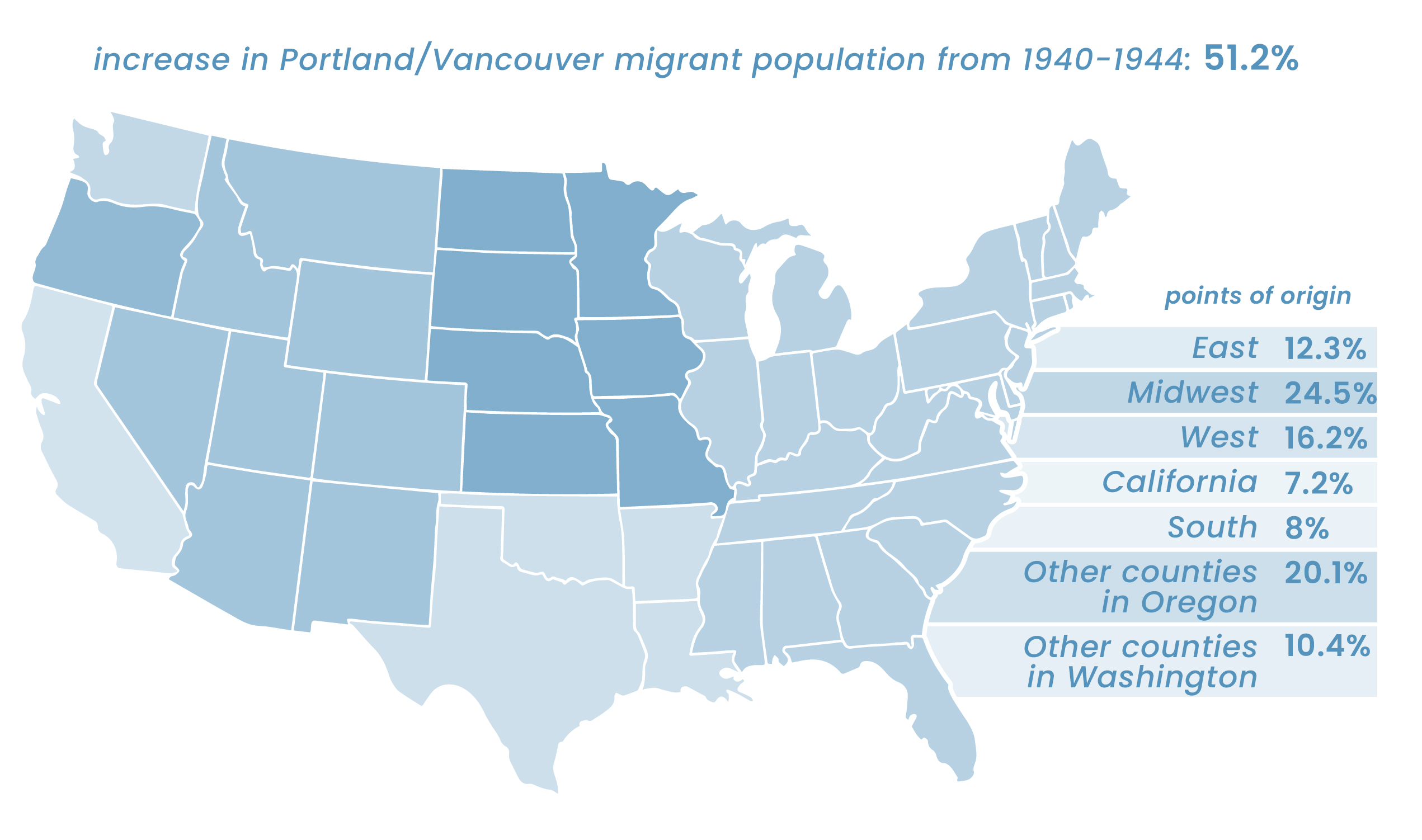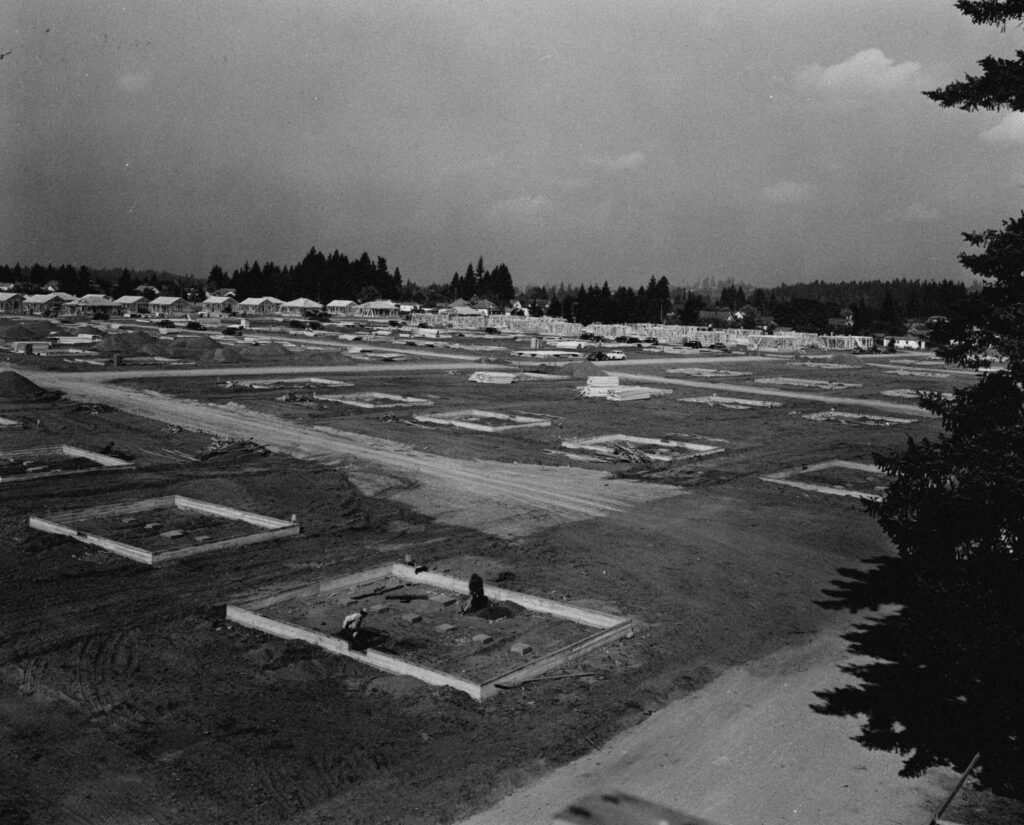Fourth Plain Forward 1.0
A Virtual HistoryIntroduction
Vancouver, Washington is often associated with the Hudson’s Bay Company, a 19th-century military fort, and the Columbia River. Less known are the stories of the neighborhoods constructed during World War II.
Part of Clark County Stories, Fourth Plain Forward 1.0 is a virtual exhibit exploring the people who lived, worked, and created communities in Vancouver’s Fourth Plain Corridor during the 1940s and today.
Wartime Comes to Clark County
As World War II escalated, demand for defense industry materials grew across the globe, causing production in Vancouver to increase.
Henry J. Kaiser opened a shipyard along the Columbia River in early 1942. The company received lucrative government contracts, turning the Vancouver area into a strong economic resource.
The growing need for ships and wartime munitions required a larger workforce. Companies, such as Kaiser’s Vancouver Shipyard, recruited workers from all over the country.
The shipyard’s initial payroll boasted 38,000 workers. Just two years earlier, the population of the entire Vancouver area was just under 30,000.
Bonus Content
For The Curious
Wartime Housing
With the growing demand for defense industry workers, city officials knew these employees and their families would need homes once they arrived in Vancouver.
This prompted city officials to establish the Vancouver Housing Authority (VHA) in 1942.
The VHA’s mission was to provide temporary rental housing and apartment units to the area’s growing workforce. The structures built during this time were never meant to remain after the war.
Associated with federal housing programs, the VHA and the city began purchasing land and building temporary housing for the new workforce. Prior to 1940, the Vancouver area had no public housing.
These housing projects included the Bagley Downs, Fourth Plain Village, and Harney Heights neighborhoods, to name a few.
In the 1940s, the VHA provided 12,000 affordable housing and apartment units to Clark County residents. These housing projects featured community centers, libraries, schools, and shopping centers.
Bonus Content
For The Curious
Bagley Downs Housing Project

Click here to see the Bagley Downs plat map.
The Bagley Downs housing project opened on September 1, 1943. It featured 2,100 units and could house nearly 8,400 people.
By the late 1940s, Bagley Downs no longer functioned as a public housing project. In 1951, it became a subdivision and a permanent part of the Fourth Plain District.
Fourth Plain Village Housing Project
Click here to see the Fourth Plain Village plat map.
Fourth Plain Village opened on February 18, 1943 with 200 housing units. This housing project could accommodate around 820 people.
By the early 1950s, Fourth Plain Village was no longer a public housing project and all of the homes had been sold to private individuals.
Harney Heights Housing Project

Click here to see the Harney Heights plat map.
Harney Heights opened in early 1943. It contained housing for up to 2,000 people.
In 1949, the city of Vancouver opposed replatting Harney Heights as a permanent public housing project.
One year later, the federal Public Housing Authority, through the VHA, began selling the temporary homes, also known as demountable housing, to returning veterans and former residents. Once purchased, the owners had 60 days to remove the homes from Harney Heights to a new location.
NAACP
In May 1943, the Vancouver National Association for the Advancement of Colored People (NAACP) Branch #1139 formed to combat racial discrimination. The group advocated for housing desegregation, increased employment opportunities, and expanded access to education for Black residents.
Mark A. Smith, David and Bertha Baugh, and Valree and Joseph Joshua, were some of the early founders of Vancouver NAACP Branch #1139. The NAACP continues to advocate and work for equality and justice throughout the community.
Post-War Vancouver
With the end of the war and the decreased demand for wartime munitions, Kaiser’s Vancouver Shipyard began laying off employees in 1945. The following year, employment at the shipyard had decreased by nearly 30,000.
This led some city officials and Vancouverites to anticipate an exodus of wartime workers and the rapid closure of public housing projects. However, a 1946 VHA survey found that a majority of defense workers wanted to stay, “jobs or no jobs.”
Removal of wartime housing was already underway before the end of the war, with some neighborhoods deconstructed as early as 1944. By June 1947, only a handful of public housing projects remained.
The removal of wartime housing projects created a new issue for the city and VHA as workers, their families, and returning veterans struggled to find affordable homes.
Many former wartime housing projects converted into privately held subdivisions. The city offered individuals living in public housing the opportunity to purchase homes, creating many of the neighborhoods in the Fourth Plain community today.
Building A Community
Located about one mile outside of downtown Vancouver, the Fourth Plain Corridor is home to a diverse community with roots in many of these historic wartime housing developments. Today, the area is home to over 23,000 residents and more than 150 family owned businesses. Residents and business owners living and working along Fourth Plain support and promote a strong community. These are a few of those individuals.
In 2018, business owners throughout the Fourth Plain and the City of Vancouver came together to establish the Fourth Plain Forward District Association. The non-profit organization supports businesses and brings the community together.
Paul Burgess joined the organization as executive director in January 2022. He is continuing efforts to develop assistance for small businesses, grow community wide events, and break ground on Fourth Plain Community Commons.
“I’m hoping over the next three to five years, to transform [FPF] from the district association that it is now to [a] community development corporation to really enable the community to have that generational legacy. So really making sure that the community we have here today is still here in five, 10, 15 years time, because they want to be and they can be.”
Paul Burgess, Fourth Plain Forward Executive Director
Thank you!
We want to thank the generous support from Humanities Washington through a SHARP Grant. Without this funding our exhibit wouldn’t have been possible.
We also want to extend a heartfelt thanks to our amazing partners Fourth Plain Forward, Washington State University-Vancouver, and Ashley Jhaveri.
We also want to thank everyone who made this exhibit possible and have participated in our Clark County Stories Project: Tanaka Axberg, Heather Beaird, April Buzby, Marilou Cassidy, Megan DeMoss, Samuel Edmundson, Annelise Gonzalez, Dalton Gunther, Kay Hall, Zane Knowlton, Geoff Lopez, MA, Robert Loren, Lyndsay Medonich, Kellie Moore, Gilbert Morales, Shalina Nail, Sue Peabody Ph.D., Sarah Pugh, Sarah Erlandsen, Liza Schade, Shawn Radford, Donna Sinclair Ph.D., Timothy Varney, Washington State Archives, and many others.
Fourth Plain Forward 1.0 is the first attempt to delve into the history of a vital part of the Clark County story. As new information is uncovered and more stories are saved, this virtual exhibit will be expanded to help further our understanding of our collective history.
Works Cited
“5,100 Families Still Living On Projects.” The Columbian. January 1, 1947.
Bachman, Ray. “‘War Boom’ End is Year’s Top Local Story.” The Columbian. January 1, 1946.
Lund, Josephine. “Housing needs of Vancouver, Washington, Part One.” 1945; Landerholm Papers, Box 4, Folder 41, Clark County Historical Museum, Vancouver, Washington, 98660.
Madsen, Chris. “Organizing a Wartime Shipyard: The Union Struggle for a Closed Shop at West Coast Shipbuilders Limited 1941-1944.” Labour/La Travail vol 65. Spring 2010 Printemps. 74-108.
Oliver, Gordon. “Kaiser Shipyards.” Oregon Encyclopedia. https://www.oregonencyclopedia.org/articles/kaiser_shipyards/#.Yf71Ct_MKUk. Last updated January 20, 2022. Accessed 2/5/2022.
“One of the First Problems.” The Columbian. July 12, 1943.
Platt, Amy E. “‘Go Into The Yard as a Worker, Not as a Woman’: Oregon Women During World War II, a Digital Exhibit on the Oregon History Project.” Oregon Historical Quarterly, 116, no. 2. Summer 2015: 234-248.
Roberts, Jack. “Vancouver Hires Negroes.” Oregon Journal. 1/17/1958.
Author Unknown. “Vancouver Leads Integration.” Oregon Journal. 1/26/1958.
Schwantes, Carlos. The Pacific Northwest: An Interpretive History. Lincoln and London: University of Nebraska Press, 1989.
Taylor, Quintard. “Swinging the Door Wide: World War II Wrought A Profound Transformation in Seattle’s Black Community.” Columbia Magazine 9, no. 2. Summer 1995: 26-32.
U. S. Census Bureau. “Population of Urban Places of 10,000 or more from earliest census to 1950. Washington State.” 1950. https://www2.census.gov/library/publications/decennial/1950/population-volume-1/vol-01-50.pdf. Accessed June 2022.
Vancouver Housing Authority. “Emergency Housing for War Peace!: The Fourth Annual Report of the Housing Authority of the City of Vancouver.” July 1946; Landerholm Papers, Box 4, Folder 41, Clark County Historical Museum, Vancouver, Washington.
Wheeler, Bayard O. “The Vancouver Plan: prepared for the City Planning Commission and Housing Authority of the City of Vancouver.” Vancouver, WA: 1947.
Williams, Melissa E. E. “Those Who Desire Very Much To Stay: African Americans and Housing in Vancouver, Washington, 1940 – 1960.” Master’s Thesis, Washington State University, 2007.
“Year Sees Windup of Housing Job.” The Columbian. December 31, 1943.



